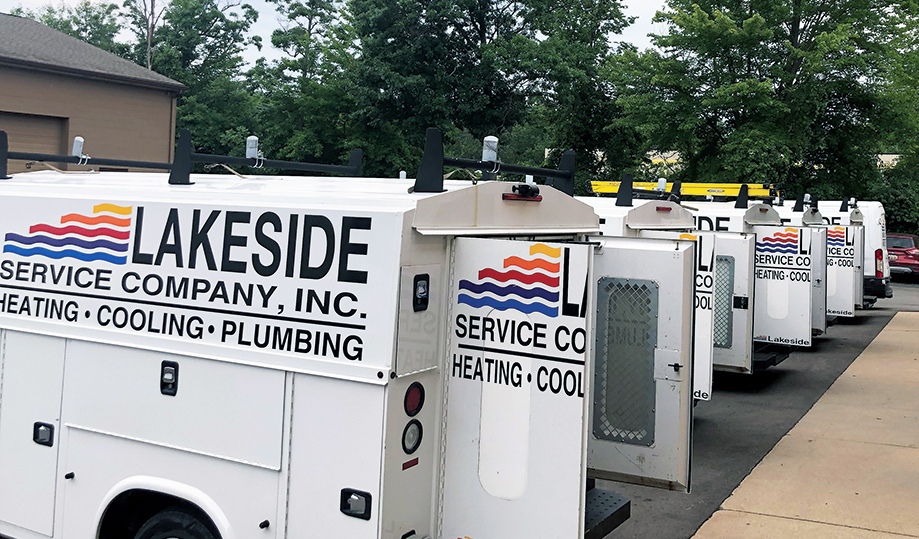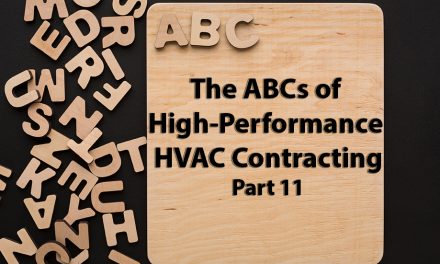Now it seems so obvious. We had hired consultants multiple times over the years to come in and teach management about the business side of things. Why didn’t we take this on-site, all hands on deck approach earlier?
I suppose partly because Lakeside never invested in this level of technician training, and I’m sure there were concerns about the cost. It certainly wasn’t part of any long-term plan the first time we did it. We just knew that we needed to do something different.
It didn’t take long to realize our techs LOVED it. Because of our on-site training, we now have all of our technicians certified. Everyone knows how to do static pressure testing and some air-side diagnostics, not just the privileged few.
Creating Processes
We soon realized that if we didn’t change our internal processes and didn’t include our air diagnostics service on our documents, forms, and daily routines, high-performance testing would never get fully implemented.
Even after the onsite training, we still had techs who weren’t comfortable testing. Plus, there was the issue regarding which tools and instruments to use.
I think we had some unrealistic expectations at first. We assumed that once trained, technicians could hop in their truck and start using the knowledge. We found that might work for a few of them, but to really get everyone onboard a little planning went a long way.

We knew craftsmen need proper tools for the job, so our first goal was to figure out what those tools should be. Right off the bat, the team needed manometers. We settled on something simple that everyone could afford. It was digital, and we made sure that each tech had one.
The next step was to focus on things we could control the most. We started to document static pressure on every maintenance call.
Once that became routine, we added static pressure testing to every installation startup. And just to give some perspective, the amount of time from the first on-site training to every installation was probably two and three years.
Data Collection and Analysis
With the guys finally doing regular testing, we needed to gather that data for analysis. We decided the smartest and quickest way was to use the NCI HeatMaxx and CoolMaxx forms. Because almost none of our techs had tablets at that time, we opted out of using apps and other software. We filled out those forms on every maintenance call and anytime there was an issue.
I loved those forms! They were easy to use and let us record our measurements and make carbon copies so we could leave one with the customer.
It was a few years into testing before we customized our forms to fit our needs. Even then, they were a combination of data recommended by equipment manufacturers and the data points on the NCI forms.
Today, we use a digital fill-able PDF that our service manager built into our Service Titan service management software system
Whichever way you decide to record the data, the important thing is that someone makes sure the testing is done, recorded, and verified on every invoice. It takes time and energy, but it needs to be done.
First Building Performance. Then High Performance
Going back before testing was company wide, near the end of 2009, my father had encouraged me to get Building Performance Institute (BPI) trained and certified. Once I completed that training, I added energy audits to my sales responsibilities. I sure learned a lot and we improved a lot of houses, but without combining static pressure testing or airflow to the process, I was missing the big picture. It wasn’t long before I realized we were overlooking the ductwork.
As a home energy tester/auditor, I could help customers achieve Energy Star specifications, but addressing the building envelope without the duct system wasn’t solving any real issues.
I think every NCI member knows if you don’t work on the heating and cooling systems, other major appliances,
and ductwork, there is no way to achieve significant energy savings. Why? Because the HVAC system consumes over 60% of the energy in a typical home.
Click Below for the Next Page





![High Performance Contracting: Summit 2018 Panel Discussion on Implementation [PART 2]](https://hvactoday.com/wp-content/uploads/2018/06/DSC_0613-Panel-Discussion-4c3-440x264.jpg)







John, it sounds like your doing most things right; however, you’re missing out on measuring the actual heat loss/gain of the home’s envelope. Without that you will never be doing the best job for the home owner.